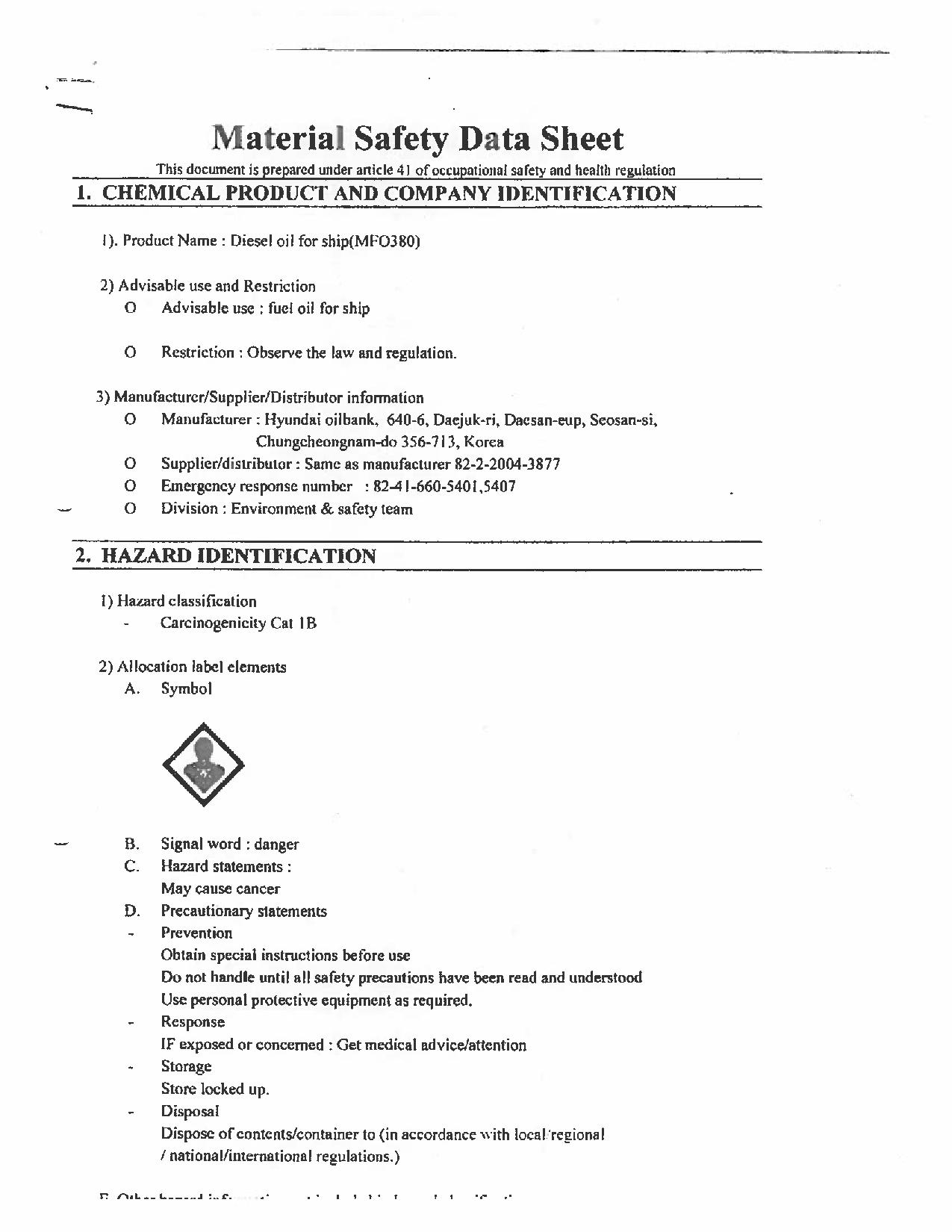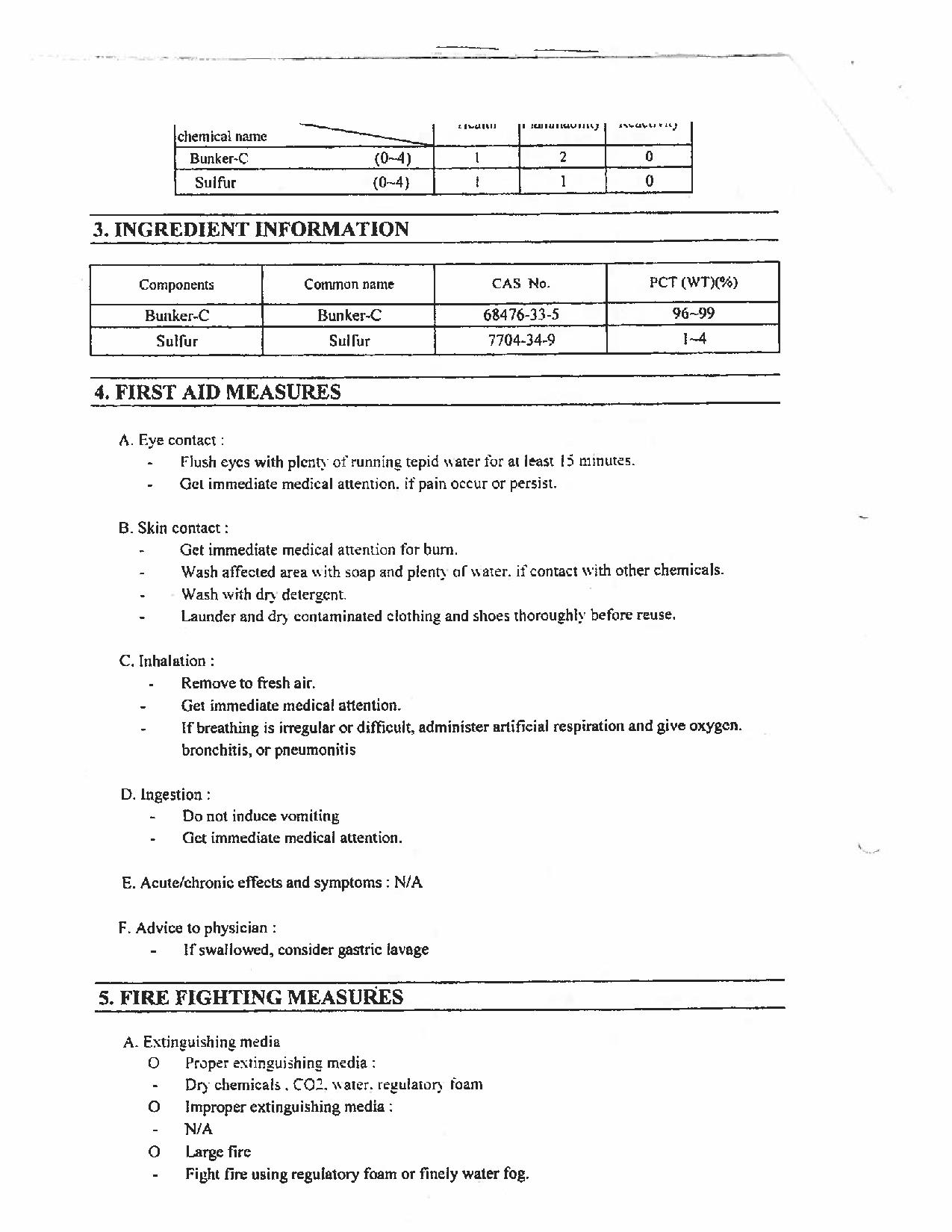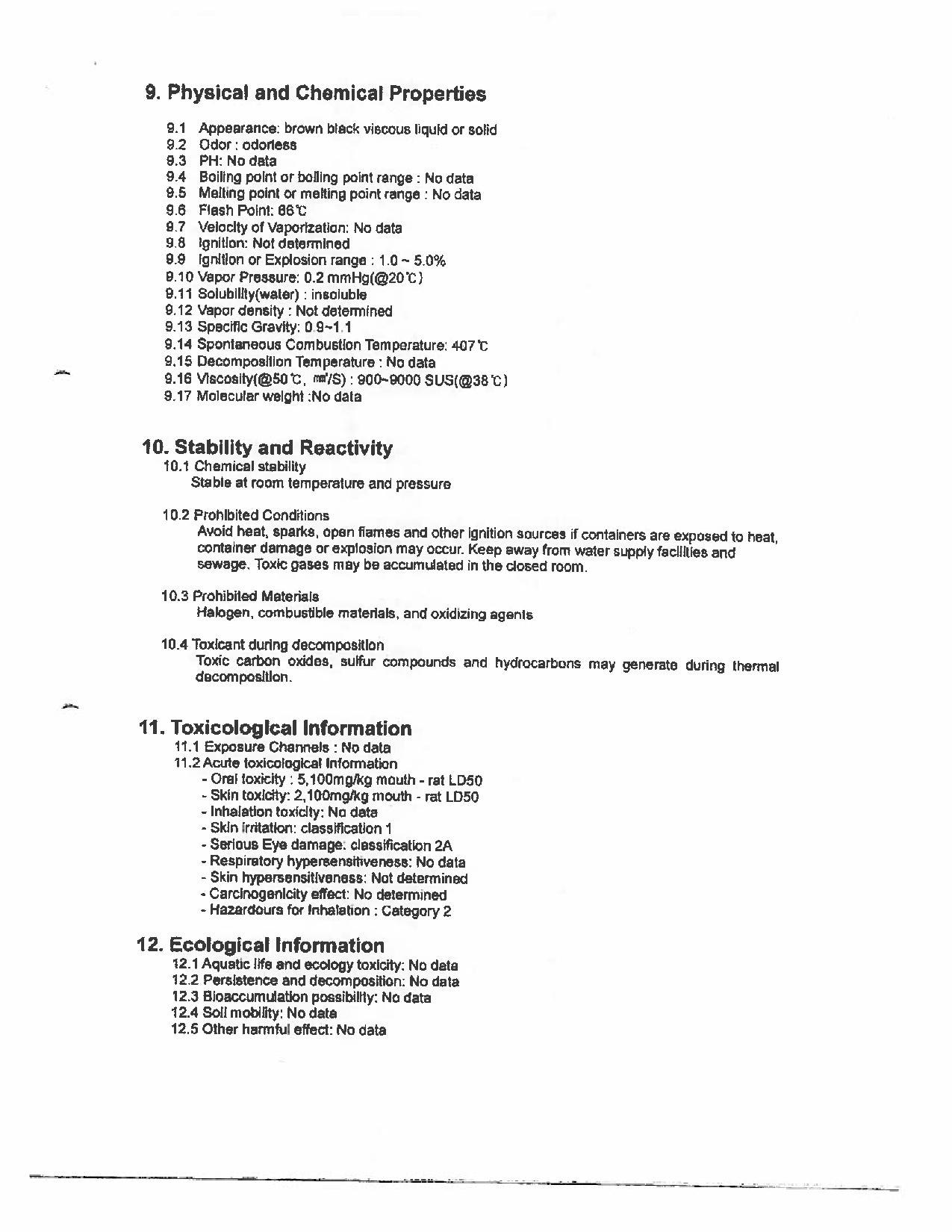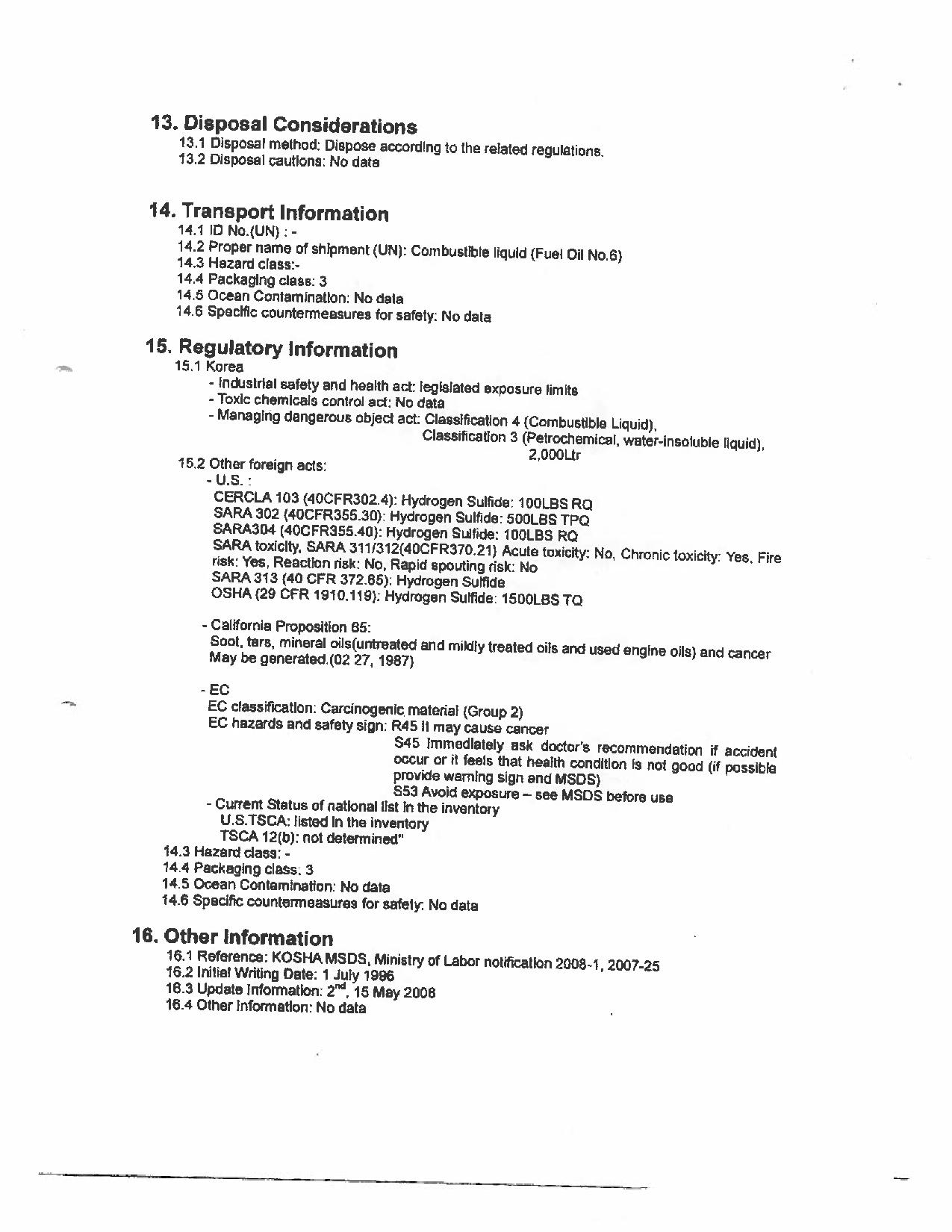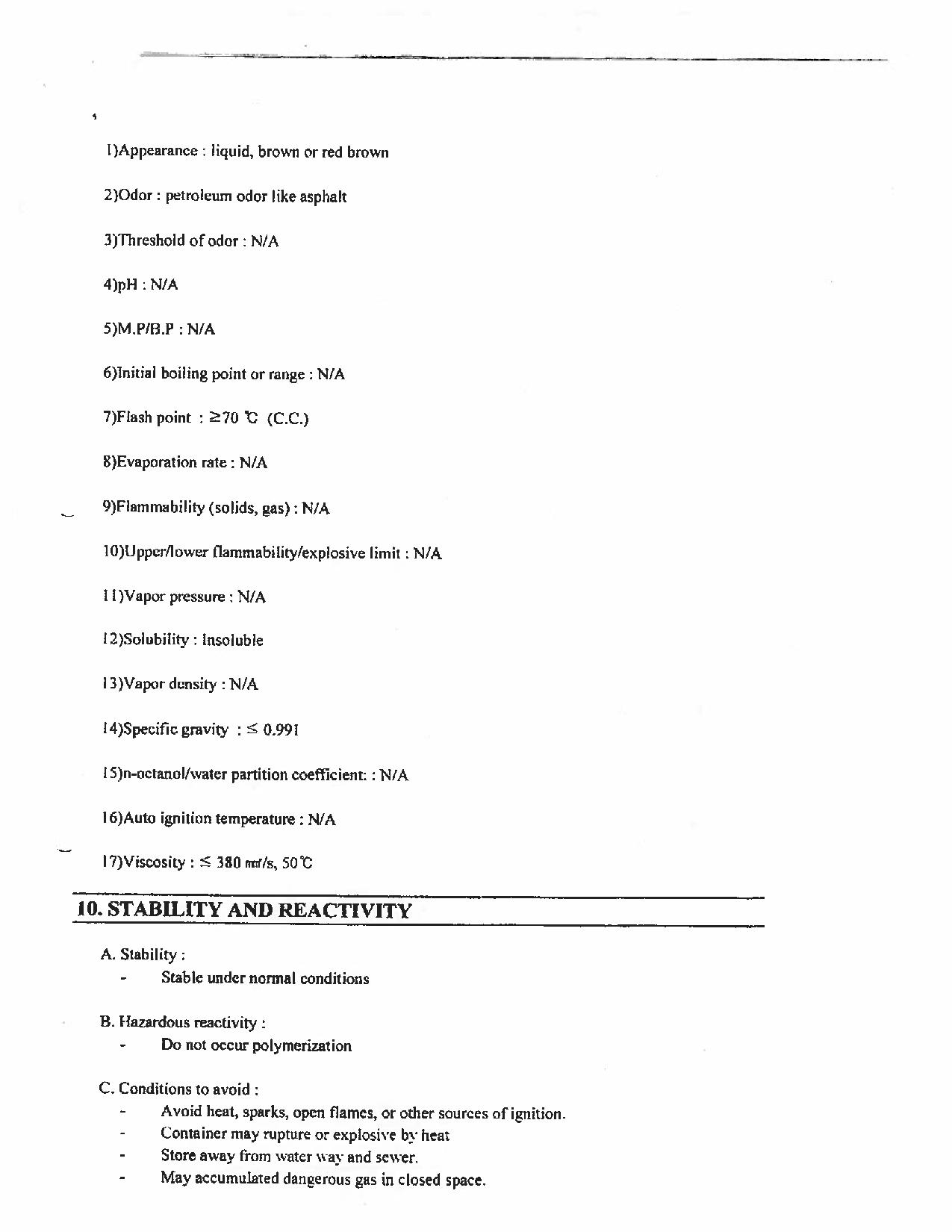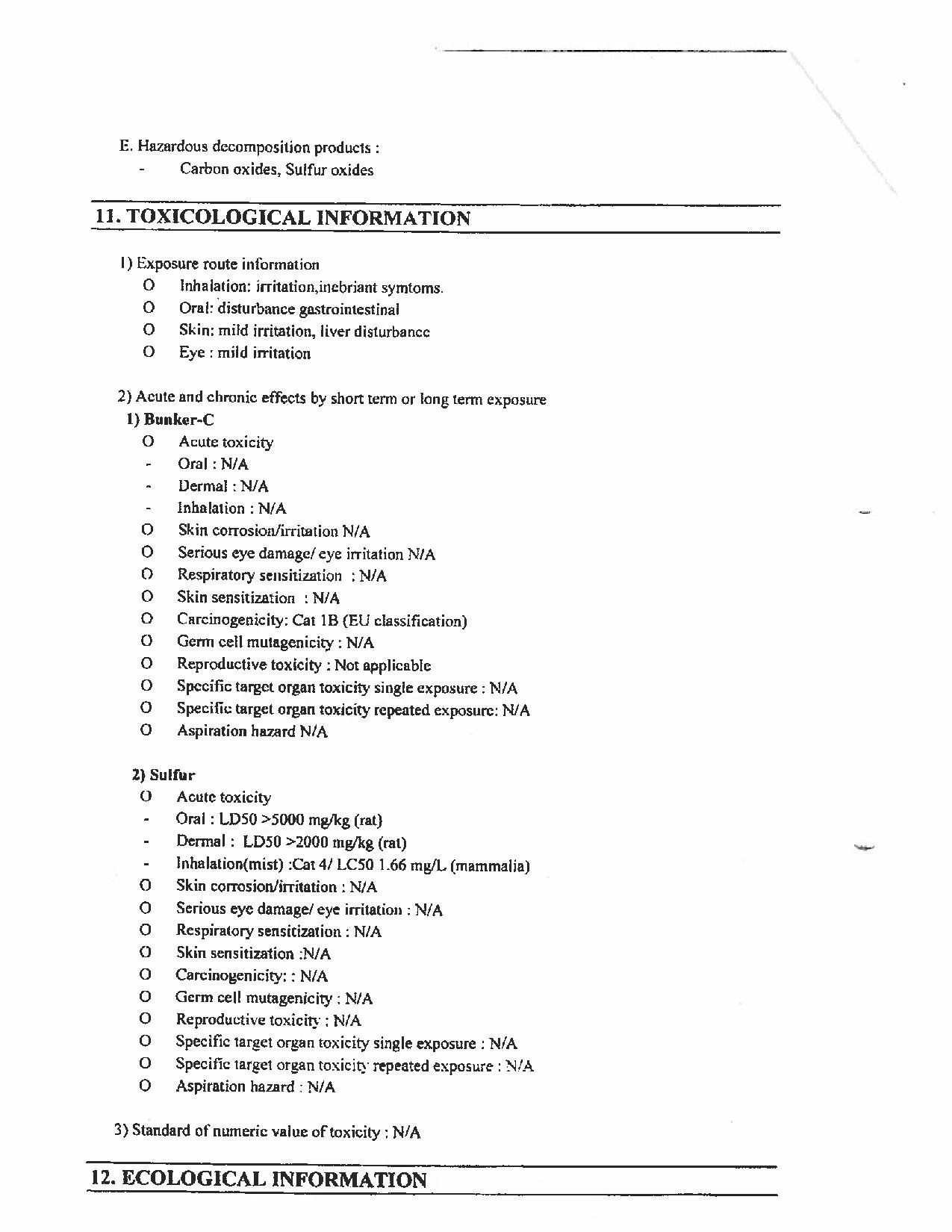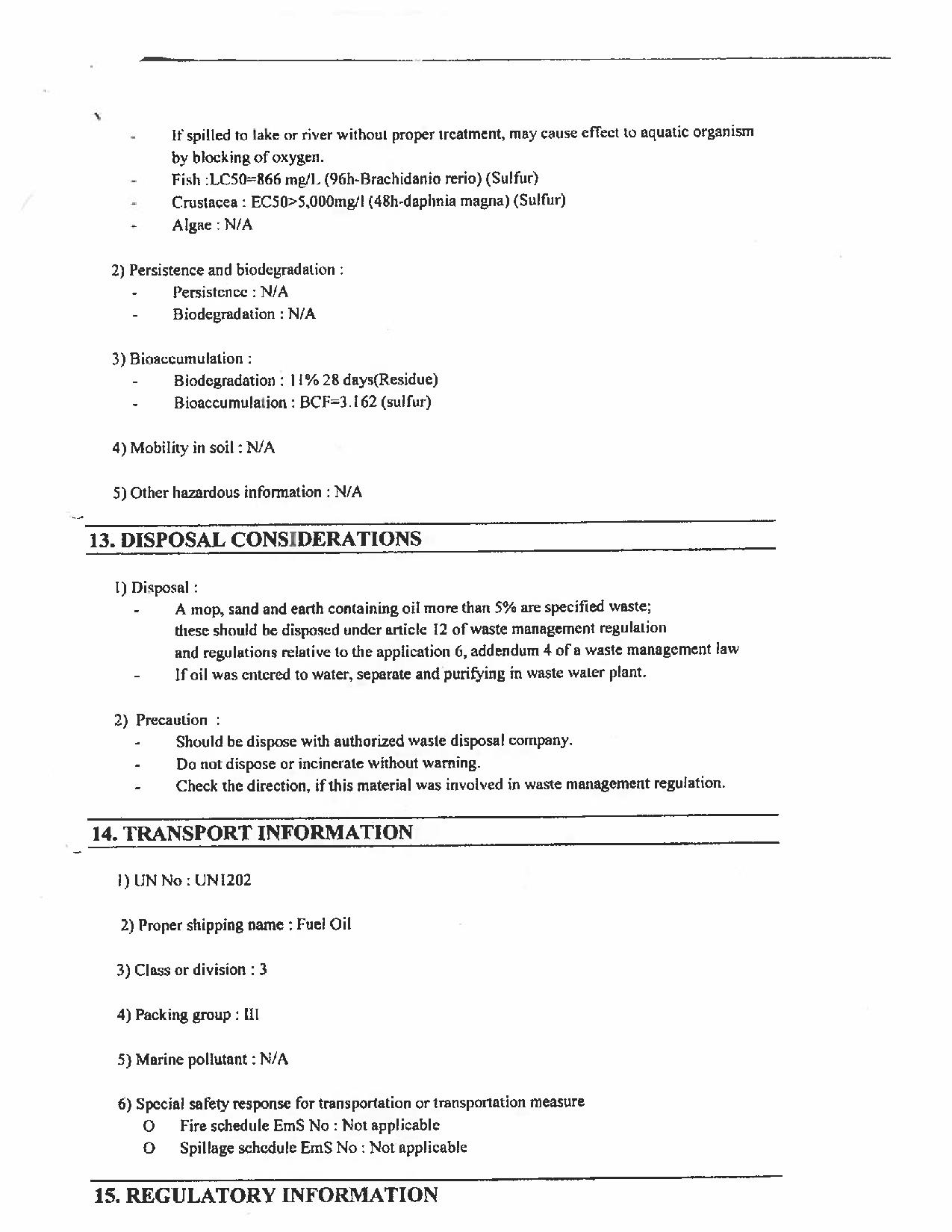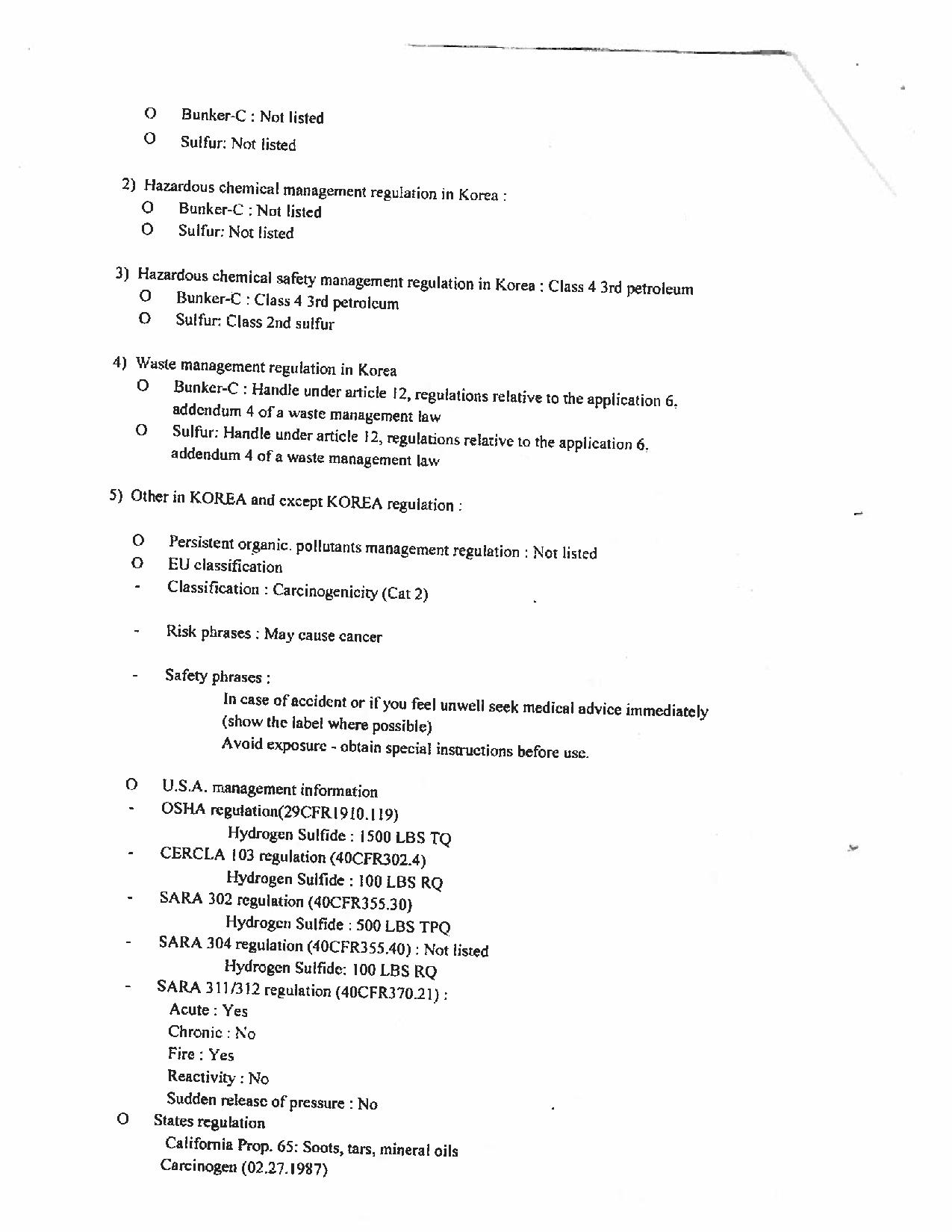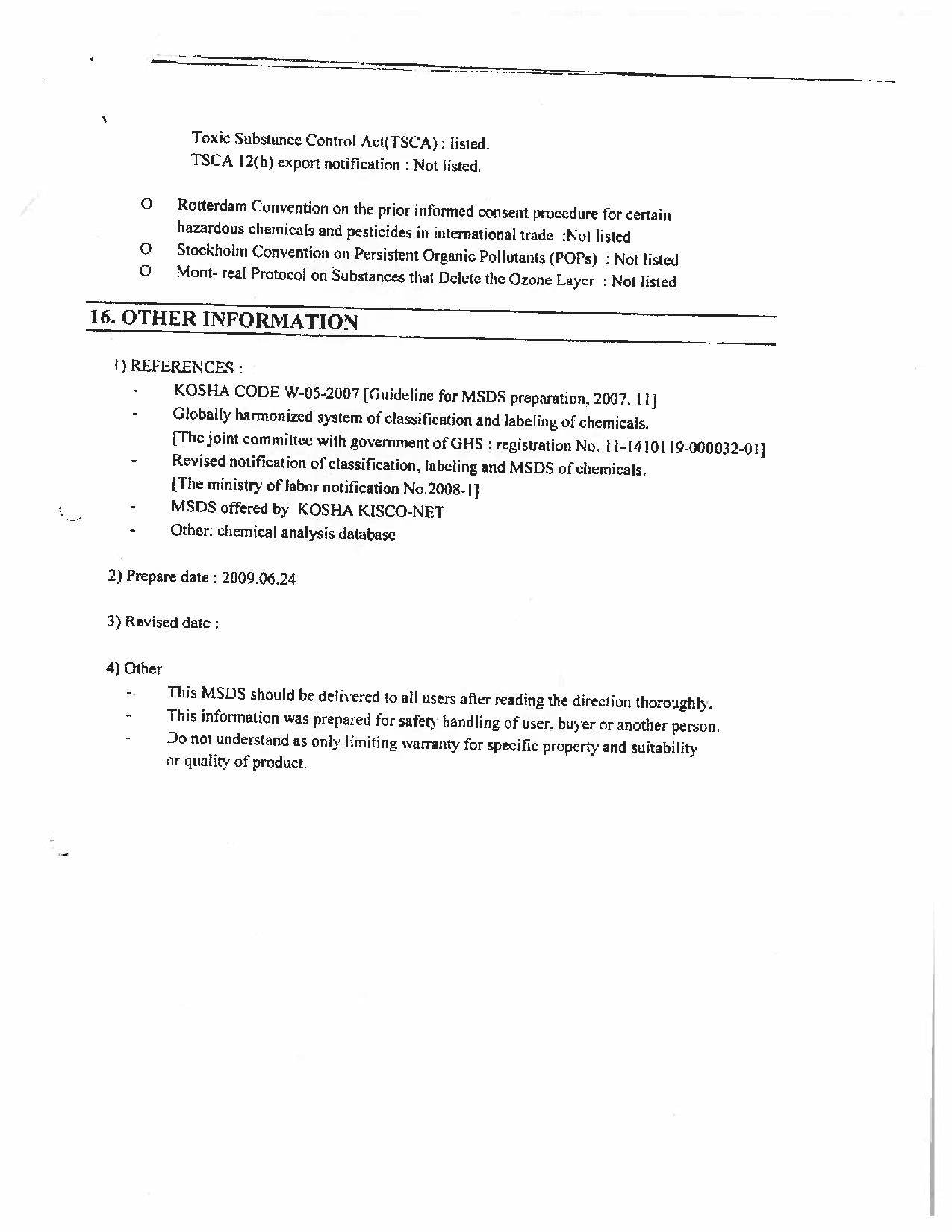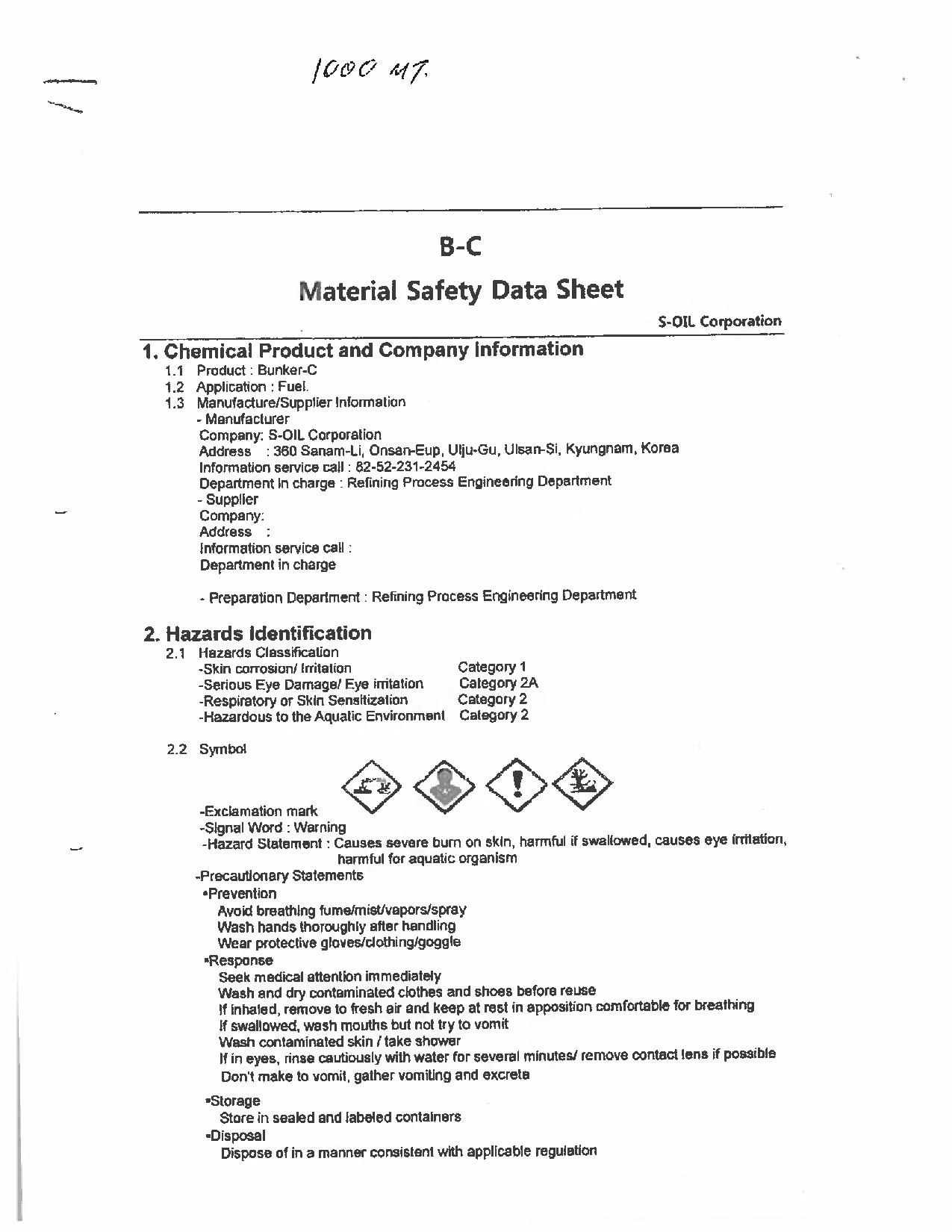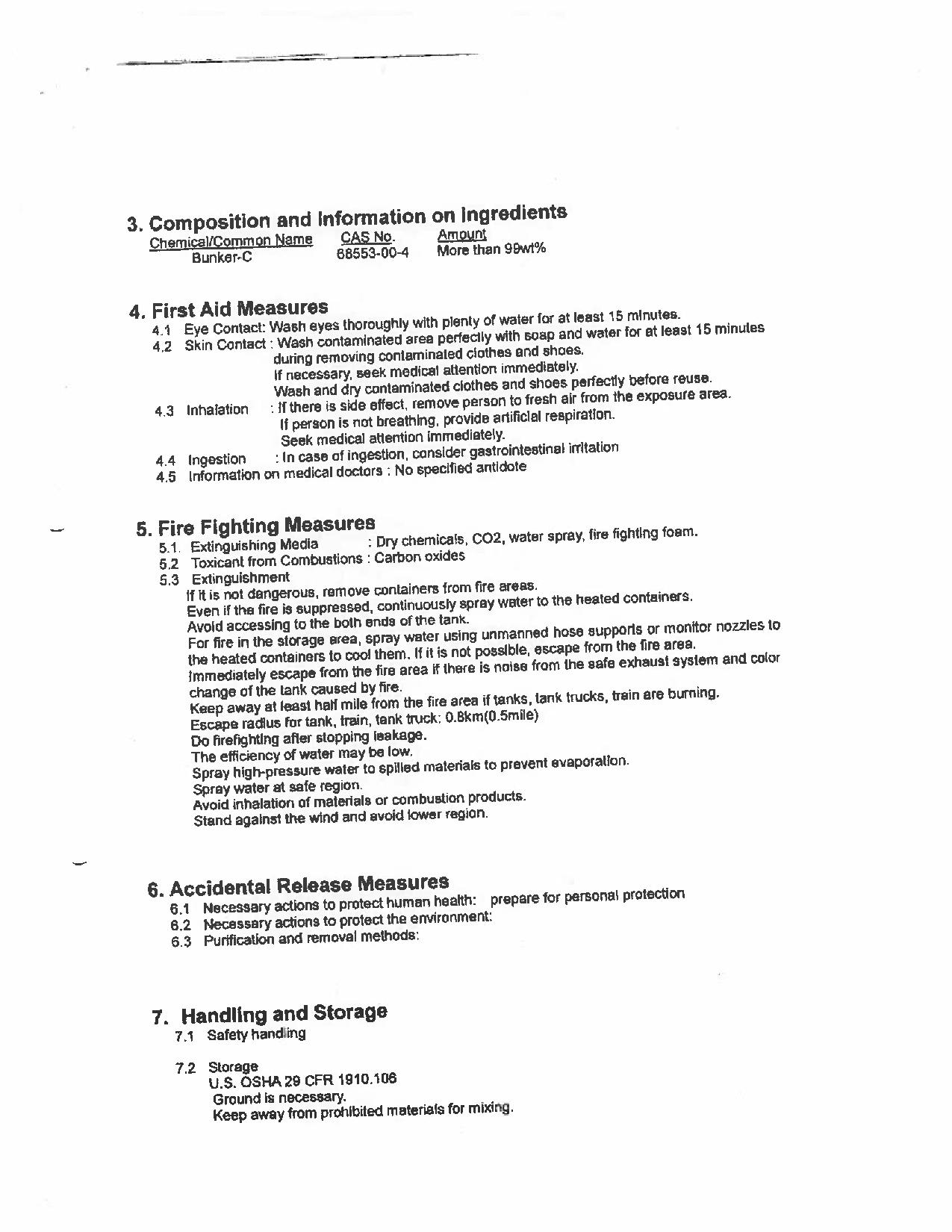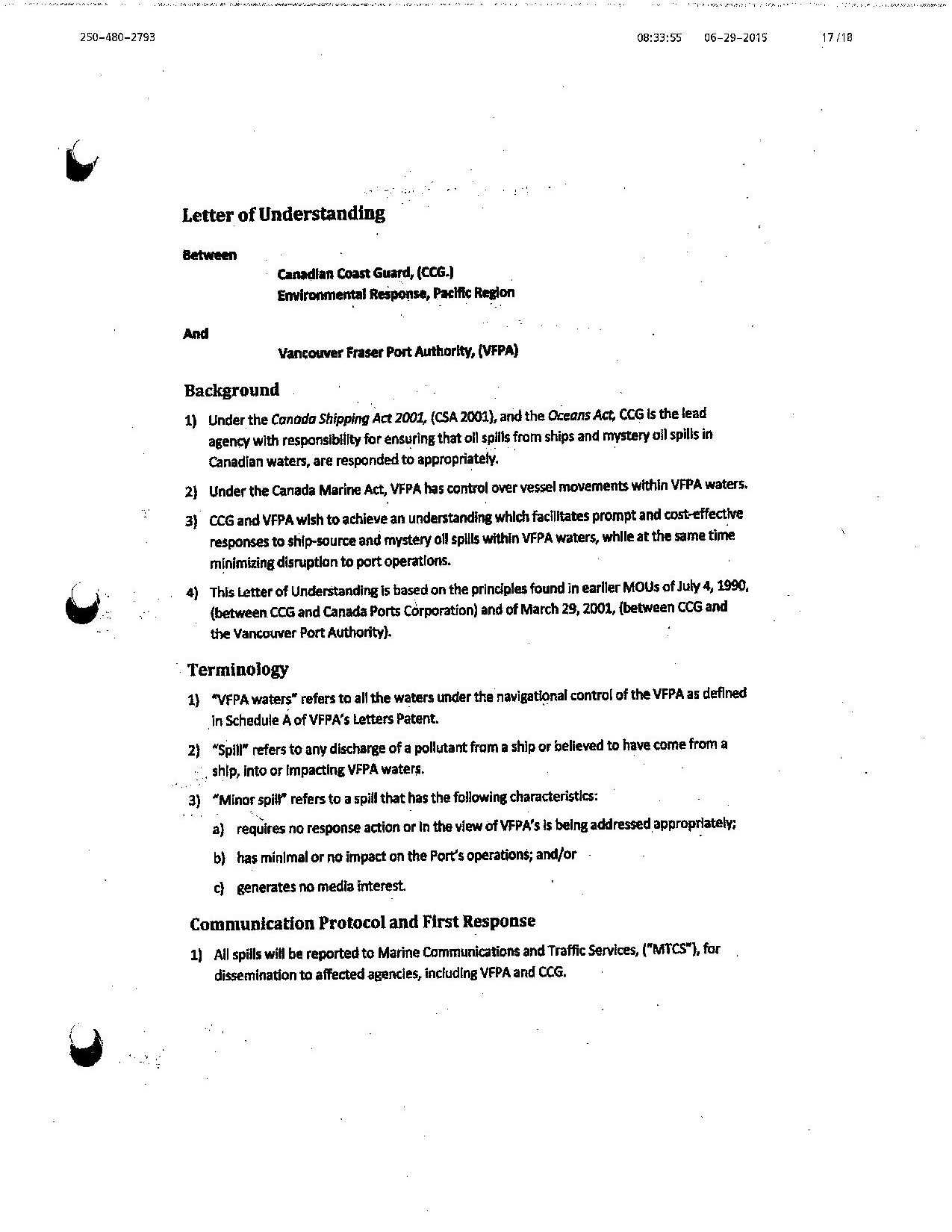Independent Review of the M/V Marathassa Fuel Oil Spill Environmental Response Operation
Annexes
Table of Content
Annexes
ANNEX A - Terms of Reference for the Review
Independent analysis and assessment of the MV Marathassa fuel spill environmental response operation in English Bay, British Columbia
TO: John Butler, Assistant Commissioner (Ret'd)
FROM: Jody Thomas, Commissioner, Canadian Coast Guard
TERMS OF REFERENCE FOR AN INDEPENDENT ANALYSIS OF THE ENVIRONMENTAL RESPONSE OPERATION ASSOCIATED WITH THE APRIL 8, 2015, MV MARATHASSA BUNKER C FUEL SPILL EVENT
You are to provide to me an independent, unbiased analysis and assessment of the Canadian Coast Guard’s (CCG) environmental response operation associated with the MV Marathassa Fuel spill event in English Bay, taking into account the provisions of the Canadian Coast Guard (CCG) Marine Spills Contingency Plan (National and Regional Chapters), Canada’s Marine Oil Spill Preparedness and Response Regime, relevant legislation, and these Terms of Reference. A broader list of legislation, plans, policies, and directives to be taken into account is included in Appendix A. Also included in Appendix A is a list of key federal authorities, other levels of government, and non-government stakeholders, which you are required to engage, at a minimum, throughout your review.
Based on official government sources of information, you are to summarize the facts surrounding the outcome of the environmental response operation from the initial call until the conclusion of the CCG response, as signified by the culmination of the Unified Command.
You are to provide me with a high-level assessment of events that occurred on the MV Marathassa’s maiden voyage between Japan and Vancouver, BC, including any significant events that may or may not have contributed to the pollution event.
You are also directed to review:
- all formal and informal protocols, written or otherwise, that guide the sequence of notifications to and among the various implicated authorities and stakeholders;
- the sequence of events and actions following identification of the oil spill;
- whether CCG and its partners in Incident Command were compliant with applicable/relevant plans, policies, procedures, directives, and work practices, and whether the response met industry and international response standards; and
- the effectiveness of the interactions between CCG and federal authorities, other levels of government, and non-government stakeholders in achieving the goals of the Incident Command System and Environmental Response functions.
With respect to this specific environmental response operation, and within the scope of your mandate, you are to provide recommendations, if deemed necessary, to improve the communications and operational protocols, standards, practices, actions, procedures, and directives that pertain to environmental response.
In addition, your analysis is not to express any conclusion or recommendation regarding the civil or criminal liability of any person or organization. For greater certainty, you are not to interfere with or to jeopardize any ongoing regulatory investigation, criminal investigation or criminal proceeding conducted by other public entities in relation to these events.
To support you in your assessment and in the development of your report, you will be supported by a Secretariat comprised of federal officials, who will provide a combination of subject matter expertise, analytical, research, writing, and administrative support.
You and the members of your team will be required to sign a document that will create an ethical wall to help ensure that you are able to provide an independent, unbiased review.
All CCG personnel are hereby required to assist you in this review by responding to questions and providing any requested documentation. Your primary CCG contact is Mr. Jeffery Hutchinson, Director General, National Strategies ( Jeffery.Hutchinson@dfo-mpo.gc.ca), Tel: 613-993-7728.
You and your team are required to manage all information related to the review in accordance with federal law, including the Access to Information Act and the Privacy Act. Any requests that you receive to share information should be discussed with Mr. Hutchinson, who will ensure that appropriate legal and expert advice is sought regarding the release of information.
Your final report will be provided to me on or before July 19, 2015. The final report will be translated and the Minister will subsequently make this report public, no later than July 31, 2015.
Legislation, plans, policies, and directives to be taken into account:
- Oceans Act
- Canada Shipping Act, 2001
- Marine Liability Act
- Emergency Management Act
- Canada’s Marine Oil Spill Preparedness and Response Regime
- Marine Spills Contingency Plan (National Chapter)
- Marine Spills Contingency Plan (Pacific Region Chapter)
- Response Management System User’s Guide, DFO/6249
- Response Management System Directive, D-3020-2002-02
- Federal Monitoring Officer Directive, D-3030-2002-01
- On-Scene Commander Directive, D-3040-2002-01
- Cost Recovery of Ship-source and Marine Pollution Response Directive, D-4010-2001-01
- Reporting of Marine Pollution Incidents Directive, D-6010-2001-01
- Canadian Coast Guard Safety and Security Manual
Key federal authorities, other levels of government, and non-government stakeholders which you are required to engage, at a minimum:
- Canadian Coast Guard
- Transport Canada, including the National Aerial Surveillance Program
- Environment Canada, including the Canadian Wildlife Service
- Western Canada Marine Response Corporation
- Port Metro Vancouver
- Emergency Management BC
- BC Ministry of Environment
- Tsleil Waututh Nation
- District of North Vancouver
- City of North Vancouver
- District of West Vancouver
- Metro Vancouver (the regional government here, formerly “Greater Vancouver Regional District”)
- Shipping Federation of Canada
- Chamber of Shipping of BC
- Squamish Nation
- Musqueam Nation
- Local Wildlife Agencies (Oiled Wildlife Society of BC and Focus Wildlife)
- Vancouver Aquarium
- Pacific Pilotage Authority
ANNEX B - Chronology of Events
Chronology of Events - M/V Marathassa incident
| Local Time | Events | Source | Comments |
|---|---|---|---|
| WEDNESDAY APRIL 8, 2015 | |||
| 11:00 | An aerial observation of the vessel earlier indicated that there was no pollution observed | Port Metro Vancouver (PMV) | |
| DISCHARGE | |||
| 16:45 | Recreational boater off of 3rd beach smelled something like asphalt and observed a large slick on the water (later phones 911 at 17:05 to report) | Sailing Vessel comment | |
| NOTIFICATION | |||
| 16:48 | Canadian Coast Guard (CCG) received a call from Vessel High Frequency Channel 12 from vessel Hali reporting oil sheen in English Bay | CCG | |
| 16:54 | Member of the public calls CCG from Sandman on Denman Street to report a slick | CCG | |
| 17:00 | Member of the public calls PMV from Sandman Hotel on Davie Street to report a slick | PMV | |
| 17:04 | CCG called PMV to notify them of the pollution report. PMV advised they had just received similar report from concerned citizen and were tasking a PMV vessel to investigate | CCG | |
| 17:05 | Recreational boater phoned 911 to report pollution. The 911 Operator took his number to pass on to CCG, via the Joint Rescue Coordination Centre (JRCC) | Sailing Vessel comment | |
| 17:07-08 | JRCC contacted the recreational boater and then passed information to CCG | Personal comment and CCG | |
| 17:08-17:10 | CCG Environmental Response Duty Officer (Prince Rupert) notified of possible oil slick | CCG | |
| 17:10-17:16 | CCG issued pollution report email to: Fisheries and Oceans Canada (DFO), Environment Canada, Transport Canada (TC), JRCC, PMV and Emergency Management BC | CCG PMV |
|
| 17:10 | PMV deployed vessel to investigate | PMV | |
| 17:12 | PMV vessel departed Main Street dock | PMV | |
| 17:14 | CCG internally alerted regarding possible oil slick around anchorage 12 | CCG | |
| 17:15 | PMV internally alerted | PMV | |
| 17:18 | PMV contacted agent for M/V Marathassa | PMV | |
| 17:22 | Province of BC received notice from CCG regarding bunker fuel oil spill in English Bay and internally alerted. | Province of BC | |
| 17:27 | Dangerous Goods Incident Report (DGIR) from Province of BC: DGIR 150065-Ocean. Code 1. Possible Bunker oil approximately 200 sq. metres. Harbour Master investigating possible oil near M/V Marathassa | Province of BC | |
| ASSESSMENT | |||
| 17:30 | PMV vessel arrived in the area and discussed with the sailing vessel Hali to identify where the concentration of oil was observed | PMV | |
| 17:35 | Captain of the M/V Marathassa acknowledged there was a substance around their vessel but denied it had come from their vessel | PMV | |
| 17:40 | PMV was in area deploying sorbent pads | PMV | |
| 17:45 | PMV contacted Nav Canada Vancouver Harbour Control Tower for assistance in identifying the source | PMV | |
| 17:50 | PMV estimates that substance is recoverable and unlikely to break up before reaching the beach | PMV | |
| 17:52 | Nav Canada Vancouver Harbour Control Tower reported that an incoming Helijet saw a sheen and identified the vessel in Anchorage 12 as the possible source | PMV | |
| 17:53 | Resident from West Vancouver phoned to report of oil on the water | CCG | |
| 17:56-17:58 | PMV reported to CCG that there appears to be recoverable pollutant in the area and requested a recovery vessel | CCG & PMV | First Assessment of recoverable oil |
| 17:58 | CCG internally discussed the reported oil slick and that PMV could task the Western Canada Marine Response Corporation (WCMRC) to respond | CCG | There is uncertainty of responsibilities under the Letter of Understanding |
| 18:00 | PMV internally alerted and alerted WCMRC of a potential call-out from CCG | PMV | |
| 18:04 | CCG internally alerted via copy of the Pollution Report | CCG | |
| 18:05 | CCG Environmental Response officer contacts PMV. They discuss a large patch of oily pollutant approximately 10m X 100m in English Bay, estimated as recoverable by the PMV vessel. PMV requests that CCG initiate spill response. CCG suggest that it could take approximately 1 hour to 90 minutes for CCG to arrive on scene and suggested that PMV contact WCMRC | PMV & CCG | |
| 18:08 | CCG provided WCMRC a ‘heads up’. WCMRC indicated they have spoken to PMV and are standing by | CCG & WCMRC | CCG expects PMV to activate WCMRC |
| 18:20 | CCG distributed Pollution Report 2015-0210 (initial Report): The Pollution Report noted that an area of 200 sq. metres of pollutant, possible Bunker C, some of it in tar balls | CCG | |
| 18:20 | PMV internally discussed CCG suggestion for PMV to activate WCMRC | PMV | PMV expects CCG to activate WCMRC |
| 18:25 | WCMRC received message from PMV via activation line, and returned call to PMV to say the local representative will contact them. WCMRC confirmed receipt of message from CCG | WCMRC, PMV & CCG | |
| 18:30 | WCMRC and PMV discussed the large slick of recoverable fuel oil in English Bay. WCMRC advised that arrival time would be about 90 minutes | PMV | |
| 18:35 | WCMRC decided to mobilize crews as an exercise | WCMRC | |
| 18:30-18:45 | PMV vessel re-checks area of major sheen (Anchorage 15 to 13) to try and locate the source of the pollution, but did not locate any other large pools. The vessel returned to area where the sorbent pads were deployed, and recovered oily pads. PMV spoke with WCMRC, who confirmed that they have not been contracted; however, were mobilizing as an exercise. | PMV & CCG | Visible oil is collected; there is confusion about who will contract WCMRC |
| 18:52 | PMV internally discuss obtaining advice from WCMRC on what they were observing | PMV & WCMRC | |
| 18:58 | PMV internally discussed the behaviour of the sheen, the small area affected, the large size of the sheen, and inability to locate the source and potential sources | PMV | |
| 19:03 | PMV vessel reports to WCMRC what they were observing; from this discussion, it is understood that PMV is standing down | WCMRC | Perception is that PMV is standing down |
| 19:15 | PMV Duty Harbour Master requests an update from the PMV vessel regarding discussion with WCMRC | PMV | |
| 19:17 | Private Cessna called PMV to offer photos that were taken at 18:52 | PMV | |
| 19:23 | WCMRC confirmed to CCG that they have been stood down by PMV | CCG | |
| 19:27 | PMV received photos from the private Cessna | PMV | |
| 19:30 | Recreational boater passing the stern of the M/V Marathassa observed activity on deck and that a PMV vessel was in the area | Sailing Vessel Comments | |
| 19:30 | PMV internally discussed the significance of the fuel oil spill following receipt of photos. Actions discussed: Board the M/V Marathassa for samples; call CCG and WCMRC. PMV returned to Main Street dock to pick up sampling kit | PMV | |
| 19:32 | CCG internally updated that WCMRC have been stood down | CCG | |
| 19:34 | PMV left a message with WCMRC advising of the significance of the spill and requested a return call. PMV then called CCG to ensure that WCMRC would be activated | PMV | |
| 19:35 | PMV internally discussed the photos taken by the Cessna that indicated a much larger fuel oil spill than originally thought. PMV vessel collected sampling kit and proceeded to English Bay to board the M/V Marathassa | PMV | |
| 19:40 | CCG internally updates that WCMRC was standing down | CCG | |
| 19:40 | CCG distributed Pollution Report 2015-0210 (Update #2) – the spill has been investigated and deemed non-recoverable | CCG at this time did not have the most up-to-date information on the extent of the fuel oil spill | |
| 19:45 | PMV called CCG, but could not connect by phone | PMV | There were connectivity issues in reaching CCG |
| 19:48 | DGIR 150065-update #1. Code 1. Spill investigated by Harbour Master and deemed not recoverable. Harbour Master vessel stood down | Province of BC | This is based on information from CCG at 19:40 |
| 19:50 | PMV vessel departs Main St. dock with sampling kits | PMV | |
| 19:51-19:52 | PMV contacted CCG and is provided alternate phone number | CCG & PMV | Spill is described as substantial |
| 19:55 | PMV contacted CCG on alternate phone number to advise of the significance of the fuel oil spill, as per the photos, and to advise that CCG needed to take action. Photos were then sent to CCG | PMV | |
| RESPONSE | |||
| 19:57 | CCG tasked WCMRC based on subsequent reports of fuel oil on water | CCG | |
| 19:58 | PMV contacted WCMRC to report lots of fuel oil on the water. WCMRC re-mobilized | WCMRC | |
| 20:01 | WCMRC confirmed to CCG that they were mobilizing | CCG | |
| 20:11 | PMV contacted TC | PMV | |
| 20:26 | WCMRC emailed work order to CCG | WCMRC | |
| 20:26 | CCG updated pollution report to indicate WCMRC had been contracted and was responding | CCG | |
| 20:35 | PMV vessel contacted by radio by M/V Marathassa to board the vessel | CCG | |
| 20:38 | CCG Vancouver contacted to take command of the response as lead agency | CCG | CCG Vancouver takes command as lead agency |
| 20:40 | CCG contacted WCMRC to exchange information and to coordinate activities | CCG | |
| 20:45 | First WCMRC vessel crewed, en route to scene | WCMRC | |
| 20:51 | CCG contacted Environment Canada (EC) National Environmental Emergency Centre (NEEC) to request trajectory modelling and environmental sensitivities | CCG | |
| 20:55 | PMV boards the M/V Marathassa for investigation | PMV | |
| 21:00 | CCG alerted TC | TC | |
| 21:04 | CCG distributed Pollution Report 2015-0210 (Update #3) – PMV has reassessed the spill from aerial photos and the spill is much larger than originally predicted. WCMRC has been contracted | CCG | |
| 21:05 | CCG sent initial National Incident Notification Protocol message (NINP) for national distribution | CCG | |
| 21:25 | WCMRC crews arrived on scene and began collecting fuel oil and skimming; source of the spill is still not identified | WCMRC | Oil recovery commenced by the Response Organization |
| 21:30 | CCG arrived at PMV | CCG | |
| 21:31 | Province of BC received pollution report from CCG that spill is larger than originally thought and was advised that WCMRC was contracted | Province of BC | |
| 21:31 | DGIR 150065-update #2. Code 1. Port reassessed and spill is larger than originally thought. WCMRC dispatched | Province of BC | |
| 21:54 | CCG contacted Vancouver Police Department (VPD) non-emergency to ask if they had any reports of oil on the beaches or smell of oil. No reports | CCG | |
| 22:09 | CCG distributed NINP #1 message. Reported significant spill with high media attention | CCG | |
| 22:10 | CCG on scene at Anchorage 12 with a PMV vessel | CCG | |
| 22:15 | Second WCMRC vessel began skimming. | WCMRC | |
| 22:15 | Province of BC spoke with CCG and advised they would have people on scene in the morning | CCG | |
| 22:30 | DFO Communications alerted by JRCC CCG arrived at anchorage 12 on board PMV vessel to begin inspection of the scene and suspect vessel | DFO CCG |
|
| 22:38 | Province of BC internally alerted: Notification – Code 1. Distributed as a head’s up | Province of BC | |
| 23:13 | CCG Vancouver provided CCG Headquarters with map and photos of spill | CCG | |
| 23:16 | CCG vessel FRC Moorhen tasked from Sea Island | JRCC | |
| 23:30 | WCMRC “MJ Green” on scene. The vessel is better equipped for night time operations with forward looking infrared camera | WCMRC | |
| 23:30 | CCG and PMV board M/V Marathassa to inspect the holds and bilge | CCG | |
| 23:54 | CCG FRC Moorhen on scene | JRCC | |
| THURSDAY APRIL 9, 2015 | |||
| 00:45 | CCG issued notice to the Captain of the M/V Marathassa to request his intentions of how he planned to respond to the fuel oil coming from his vessel. A response was requested by 05:00 | CCG | |
| 01:13 | CCG requested a NOTSHIP for vessels to reduce their speed while transiting English Bay to minimize the spread of pollution | CCG | |
| 01:15 | CCG received update from WCMRC regarding skimmed fuel oil volumes (approximately 800L) | CCG | |
| 01:19 | CCG received trajectory modelling from EC | CCG | |
| 02:57 | Province of BC received update from CCG, who requested further contact | Province of BC | |
| 02:57 | DGIR 150065-update #3. Code 1. CCG requests to speak with Province of BC regarding the incident | Province of BC | |
| 03:07 | Province of BC in Prince George spoke with CCG | CCG | |
| 03:22 | CCG distributed Pollution Report 2015-0210 (Update #5) – WCMRC crews continue to skim, CCG is on scene, TC overflight planned for first light. No known source, continue to investigate. Oil sightings have been limited to sparse patches and tar balls | CCG | |
| 03:25 | CCG and WCMRC determined need to boom vessel, after indications of fresh fuel oil being discharged from the M/V Marathassa. Estimated 1 cubic metre of heavy oil recovered so far | WCMRC | |
| 04:36 | WCMRC began deployment of boom around M/V Marathassa | WCMRC | |
| Footnote 2605:00 | A representative for the M/V Marathassa contacted CCG and denied the vessel was the source of pollution | CCG | |
| 05:17 | DGIR 150065-update #4. Code 1. CCG on scene, TC overflight planned. WCMRC conducting skimming ops. No source identified | Province of BC | |
| 05:25 | Booming of vessel complete | WCMRC | Source of fuel oil is contained approximately 12.5 hours after the initial report |
| 06:00 | WCRMC called the City of Vancouver to advise that WCMRC had been activated for a spill that now appears to be significant | WCMRC | A standard practice for WCMRC |
| 06:27 | CCG requested space from PMV to coordinate response; PMV Emergency Operations Centre (EOC) was activated. City of Vancouver contacted PMV for an update | PMV | |
| 06:30 | Vancouver Coastal Health (VCH) alerted by the City of Vancouver of the spill in English Bay | Vancouver Coastal Health | |
| 07:00 | CCG, as lead agency, established Unified Command at PMV. Fuel oil patches were throughout English Bay with pollution sheen reaching Vancouver and West Vancouver Beaches | CCG | Unified Command established with CCG lead |
| 07:00 | North Shore Emergency Management Office (NSEMO) was contacted by WCMRC | City of West Vancouver, City of North Vancouver, District of North Vancouver | |
| 07:30 | Province of BC arrived at PMV; a City of Vancouver representative was already present | Province of BC | |
| 07:45 | PMV contacted the Province of BC and asked why the City of Vancouver had not been contacted through pollution reports. PMV was informed that this is a federal concern |
PMV | |
| 08:21 | The City of Vancouver contacted the Province of BC to request task # to activate in response to spill. The Province of BC assigned TASK # 160240 | Province of BC | |
| 08:30 | Vancouver Aquarium alerted of the spill via the media. Activated their assessment team to assess the risks to the Aquarium | Vancouver Aquarium | |
| 09:00 | Tsleil’Waututh First Nation alerted by the Province of BC |
Tsleil’Waututh | |
| 10:11 | Province of BC confirmed that First Nations, VCH, Oiled Wildlife Society and Vancouver Aquarium had been notified |
Province of BC | |
| 10:15 | CCG Helicopter overflight of English Bay with representatives from ER, the Province of BC and WCMRC | WCMRC | |
| 11:00 | First Media Brief held by CCG | DFO Communications | First Formal media briefing |
| 11:48 | CCGS Siyay tasked to support response communications English Bay | JRCC | |
| 12:20 | NASP overflight estimates 2800 L oil on water. CCG flight estimates 2000 L in the main black oil slick. No shoreline impact or distressed wildlife observed | WCMRC | |
| 12:48 | CCG NINP update #1 issued: WCMRC responding to the spill; 3 WCMRC Vessels using Skimming Equipment recovering oil. Spill source remains a mystery, but suspect vessel has been boomed. TC is on board the suspect vessel today. CCG Helicopter tasked to perform overflight with ER Specialist on board; ETA on scene 1015PDT. TC 951 (NASP Aircraft) has been tasked and will be overhead at 10:45 | CCG | |
| 14:00 | CCG Helicopter transports CCG personnel from Victoria to Vancouver to participate in Unified Command | CCG | |
| 14:40 | CCG Environmental Response Pollution Response Vessel III 735 away from Steveston, proceeding to English Bay | JRCC | |
| 15:00 | Media Brief with CCG | DFO Communications | |
| 15:02 | NSEMO contacted the Province of BC to request task # to activate in response to spill | Province of BC | |
| 15:27 | DGIR update #6. Incident elevated to Code 2 based on extensive media coverage and resource demands beyond local government capabilities | Province of BC | Province elevates to Code 2 |
| 18:06 | NASP overflight estimates 667.7 litres of oil on water in English Bay, mostly grey sheen with occasional patches of brown/black oil | TC | |
| 19:00 | No oiled wildlife has been observed at collection sites. TC officers have inspected on board and are not yet able to confirm source. Shoreline assessments are being carried out by WCMRC and MOE, some oil reported at variety of sites | ||
| 19:52 | CCG Headquarters personnel arrive in Vancouver with the Commissioner | CCG | |
| 20:00 | Media brief with CCG | DFO Communications | |
| 21:30 | TC advised (unofficial) that M/V Marathassa was the likely source of pollutant | ||
| 22:48 | CCG distributes NINP update #2. Updated on water activities | CCG | |
| Unspecified | Stanley Park Ecological Society (SPES) informed of the spill by Aquarium staff and Parks Board. Arrived at Second Beach looking for presence of oil | SPES | |
| FRIDAY APRIL 10, 2015 | |||
| 06:00 | Incident Command Incident Action Plan (IAP) for the day: Continue with SCAT Continue with Shoreline clean Mobilize for Wildlife Recovery Prepare for demobilization |
ICP Records | |
| 08:30 | Media briefing with CCG and TC | DFO Communications | |
| 09:12 | NASP overflight estimates 40 litres of oil on water English Bay | NASP | |
| 10:30 | DFO Communications invited into Unified Command | DFO Communications | |
| 12:00 (east) | VCH invited to participate in the Environmental Unit after a CCG media briefing | VCH | |
| 14:00 | Media briefing with Minister Moore and CCG | DFO Communications | |
| 14:10 | NASP overflight estimates 5.9 litres of oil on water, non-recoverable | TC | |
| 20:00 | Noted in ICP Brief that a representative from the vessel owner has agreed they are the responsible party (RP) | ICP Records | |
| 20:00 | TC contracted divers to inspect the hull of M//V Marathassa– no conclusive report was determined at this time | TC | |
| 21:10 | CCG NINP update #3: Detailing activities on the water, on the shoreline and in the ICP | CCG | |
| SATURDAY APRIL 11, 2015 | |||
| 00:55 | TC issues detention order to M/V Marathassa | TC | |
| 06:00 | Incident Command IAP: Continue with SCAT Continue with shoreline clean-up Mobilize for wildlife recovery Prepare for demobilization |
ICP Records | |
| 07:00 | CCG Pollution Response Vessel II tasked to support shoreline clean-up at Siwash Rock (Stanley Park). PRV III tasked to Vanier Park (South shore English Bay) to support shoreline clean-up | CCG | |
| 10:00 | Media briefing with CCG and other federal partners | DFO Communications | |
| 10:36 | NASP overflight noted a light sheen of oil off stern of M/V Marathassa, calculated at 0.3 litres | TC | |
| DFO took on Public Information Officer role in Unified Command | DFO Communications | ||
| 14:28 | CCG NINP update #4: ICP open, Shoreline clean up, decontamination of vessels, and waterlines of ships, monitor wildlife rescue and rehabilitation | CCG | |
| 14:30 | Media briefing with CCG and Provincial of BC | DFO Communications | |
| SUNDAY APRIL 12, 2015 | |||
| 00:55 | TC issues detention order to M/V Marathassa | TC | |
| 06:00 | Incident Command IAP: Control of Oil spill is complete Objective for the day: Continue with SCAT Continue with Shoreline clean-up Continue with wildlife recovery operations Demobilization planning Water sampling and sediment sampling |
ICP Records | |
| 7:00 | CCG PRV II tasked to support shoreline clean-up at Siwash Rock (Stanley Park). PRV III tasked to Vanier Park (South shore English Bay) to support shoreline clean-up | ||
| 10:00 | Media briefing with CCG | DFO Communications | |
| 10:36 | NASP overflight noted a light sheen of oil off stern of M/V Marathassa, calculated at 0.3 litres | TC | |
| Afternoon | DFO visited Unified Command | DFO | |
| MONDAY APRIL 13, 2015 | |||
| 06:00 | Incident Command IAP: Continue with SCAT Continue with shoreline clean-up Vessel cleaning, including casualty (i.e. M/V Marathassa) Demobilization if warranted Mass Balance Update stakeholder and public communications |
ICP Records | |
| 10:00 | Media briefing with CCG | DFO Communications | |
| 18:04 | CCG NINP update #5: Updates activities in the ICP | CCG | |
| Unspecified | Vancouver Aquarium invited to join the Environmental Unit | Vancouver Aquarium | |
| Unspecified | ITOPF arrived in Vancouver | ITOPF | |
| TUESDAY APRIL 14, 2015 | |||
| 06:00 | Incident Command IAP: Continue with SCAT Continue with shoreline clean-up Vessel cleaning including casualty Demobilization if warranted Mass Balance Establish post-ICP project team |
ICP Records | |
| 10:00 | Technical panel led by CCG | DFO Communications | Last formal media briefing |
| 18:26 | CCG NINP update #6: Updates activities in the ICP | CCG | |
| WEDNESDAY APRIL 15, 2015 | |||
| 06:00 | Incident Command IAP: Continue with SCAT Continue with shoreline clean-up Vessel cleaning including casualty Conduct under hull cleaning of oil by divers Mass Balance Establish post- incident project team including decision to procure third party consultant Complete testing to support decision to open fisheries and beaches (sediment and crabs) Wildlife management |
ICP Records | |
| 17:53 | CCG NINP update #7: Updates activities in the ICP | CCG | |
| THURSDAY APRIL 16, 2015 | |||
| 06:00 | Incident Command IAP: Continue with SCAT Continue with shoreline clean-up Demobilization if warranted Mass Balance Establish post-incident project team, including decision to procure third party consultant Complete testing to support decisions to open fisheries and beaches (sediment and crabs) |
ICP Records | |
| 16:01 | CCG NINP update #8: Updates activities in the ICP | CCG | |
| FRIDAY APRIL 17, 2015 | |||
| 06:00 | Incident Command IAP: Continue with SCAT Continue with shoreline clean-up and signoffs Vessel Cleaning including the casualty Demobilization Mass Balance Establish post-incident project team including decision to procure third party consultant Complete testing to support decision to open fisheries and beaches (sediment and crabs) |
ICP Records | |
| 18:01 | CCG NINP update #8: Updates activities in the ICP | CCG | |
| SATURDAY APRIL 18, 2015 | |||
| 06:00 | Incident Command IAP: Continue with SCAT Continue with shoreline clean-up and signoffs Vessel Cleaning including the casualty Demobilization Mass Balance Complete testing to support decision to open fisheries and beaches (sediment and crabs) |
ICP Records | |
| 18:01 | CCG NINP update #9: Updates activities in the ICP | CCG | |
| SUNDAY APRIL 19, 2015 | |||
| 06:00 | Incident Command IAP: Continue with SCAT Continue with shoreline clean-up and signoffs Demobilization Mass Balance Complete testing to support decision to open fisheries and beaches (sediment and crabs) Demobilization for on-water assets Long term Project Monitor Plan and Communications Release Long term Data Management Plan Wildlife centre start to demobilize |
ICP Records | |
| 18:02 | CCG NINP update #10: ICP has consolidated, and moved into the DFO Offices at 401 Burrard. As the M/V Marathassa incident is nearing an end, the English Bay Project Management Office is being mobilized, terms of reference being drafted | CCG | |
| 20:10 | NEEC arrived in Vancouver | EC | |
| MONDAY APRIL 20, 2015 | |||
| 06:00 | Incident Command IAP: Continue with SCAT – North shore beaches (John Lawson) Continue with shoreline clean-up and signoffs Demobilization Mass Balance Complete testing to support decision to open fisheries and beaches (sediment and crabs) Demobilization for on-water assets Establish Project Monitor Plan and Communications Release Establish Data Management Plan Wildlife centre demobilize |
ICP Records | |
| TUESDAY APRIL 21, 2015 | |||
| 06:00 | Incident Command IAP: Escort M/V Marathassa from anchorage to berth with escort and response vessels Continue with SCAT – North shore areas B,C and D by CG vessel Continue with shoreline clean-up and signoff – John Lawson Demobilization Start of cleaning or on-water assets – shelter Island – Burrard Clean #7 Complete testing to support decision to open fisheries and beaches (sediment and crabs) Define requirements for Data Management Plan - Access Wildlife centre demobilize – forecasting completion Forecast transport of EC and partners to Vancouver Inner harbour |
ICP Records | |
| WEDNESDAY APRIL 22, 2015 | |||
| 06:00 | Incident Command IAP: Continue with SCAT – Vancouver Harbour and North Shore, as required Continue with shoreline clean-up and signoff –John Lawson Demobilization Complete testing to support decision to open fisheries and beaches (sediments and crabs) Define requirements for Data Management Plan |
ICP Records | |
| THURSDAY APRIL 23, 2015 | |||
| 06:00 | Incident Command IAP: Continue with SCAT – Vancouver Harbour and North Shore as required Continue with shoreline clean-up and signoffs –John Lawson Demobilization of ICP pending |
ICP Records | |
| FRIDAY APRIL 24, 2015 | |||
| 06:00 | Incident Command IAP: Response Team stood-up John Lawson Beach clean-up at its end point Complete testing to support decisions to open fisheries and beaches (sediment and crabs) Demobilization of ICP and hand-over to Project Management Office commenced |
ICP Records | |
ANNEX C - Canada's Marine Oil Spill Preparedness and Response Regime
Canada’s Marine Oil Spill Preparedness and Response Regime sets out the framework and requirements for preparing for and responding to ship-source oil spills in Canadian waters south of the 60th parallel.
The Regime was established in 1995 to address recommendations from the Public Review Panel on Tanker Safety and Marine Spills Response Capability (the Brander-Smith Panel), and to respond to increasing concerns following a number of high profile marine oil spills (the Exxon Valdez, the Rio Orinoco, and the Nestucca).
The Regime places the onus on the polluter, or the ‘Responsible Party’ to take full responsibility for the cost of any damages caused by an oil spill, which is called the “polluter pays principle”. This can include taking actions directly to prevent, reduce or eliminate the source of pollution, or using the services of a third party.
The polluter pay principle is supported by both industry and the federal government. Industry is responsible for providing Canada’s response capability and the federal government is responsible for providing the legislative and regulatory framework, and ensuring that response operations are carried out appropriately to minimize damage to the marine environment.
Response Organizations
Industry bears the liability and responsibility to respond in the event of an oil spill in Canadian waters and represents Canada’s primary response capacity. To operate in Canada, prescribed vessels of a certain size (oil tankers of 150 gross tons and all vessels of 400 gross tons trading in Canadian waters) are required to have an arrangement with a Transport Canada (TC)-certified Response Organization, which carry out industry’ s operational role to maintain Canada’s response capacity. Vessels of the above-prescribed size must also have Shipboard Oil Pollution Emergency Plans (SOPEP), as required by the International Convention for the Prevention of Pollution from Ships (MARPOL).
Response Organizations are funded by shippers and oil interests, and are required to meet a uniform planning standard to maintain the on-hand capacity to respond to spills of 10,000 tonnes within prescribed time standards and operating environmentFootnote 27. Response Organizations must submit an oil spill response plan every three years to TC to demonstrate this preparedness capacity. This plan must include an exercise and training program, provide a certain amount of temporary storage, clean-up 500m of shoreline per day, and complete on-water recovery within 10 days of deployment. Response Organizations are re-certified every three years.
South of the 60th parallel, there are four certified Response Organizations: WCMRC, Eastern Canada Response Corporation Ltd., Point Tupper Marine Services, and Atlantic Emergency Response Team.
Western Canada Marine Response Corporation
WCMRC’s geographic area of responsibility extends the length of British Columbia (BC) and out to the Exclusive Economic Zone. WCMRC has eight reference and resource Area Plans that describe area sensitivities, Incident Command Post locations, staging areas, vessel launch locations, helispots, protection/treatment strategies, equipment resources, and logistical support services. These plans are provided to TC every three years for certification purposes, and are not publicly available.
Federal roles and responsibilities
The Regime relies on interdepartmental collaboration between TC, the Canadian Coast Guard (CCG), and Environment Canada (EC) to provide three primary functions:
- TC provides the legislative and regulatory framework and oversight for the Regime (e.g. inspections and enforcement, certification of Response Organizations, and ensuring the appropriate level of preparedness is available to respond to marine oil spills in Canada);
- CCG oversees the industry’s response to ship-source and takes over the response when the polluter is unknown, unwilling or unable to respond; and
- EC provides and coordinates scientific, environmental and wildlife information and advice, with support from Fisheries and Oceans Canada and other experts.
In the event of an oil pollution incident, at the request of the CCG, EC will establish a Science Table comprised of experts from federal, provincial and municipal government agencies responsible for environmental protection, as well as experts from industry and non-government associations to coordinate and provide scientific and technical advice and information.
This partnership is further supported by a multi-layered system of other levels of government, including First Nations, and stakeholders who also have a role in preparing for and responding to marine oil spills in their local communities.
Legislative and regulatory framework
Three legal instruments form the basis of the Federal Regime:
- Part 8 of the Canada Shipping Act, 2001, which outlines the roles and responsibilities for the Ministers of Transport and Fisheries and Oceans regarding pollution prevention and response;
- The Response Organization and Oil Handling Facilities Regulations, which explain the procedures, equipment and resources of Response Organizations and Oil Handling Facilities for use in respect of an oil pollution incident; and
- The Environmental Response Arrangements Regulations, which outlines which vessels and oil handling facilities, are required to have an arrangement with a Response Organization for pollution response.
These domestic legal instruments are supported by international standards and conventions established by the International Maritime Organization. Two international agreements allow TC to fulfill its roles in preventing and preparing for marine pollution incidents:
The International Convention for the Prevention of Pollution from Ships (MARPOL), which is domestically enforce via the Canada Shipping Act, 2001, and is supported by the Vessel Pollution and Dangerous Chemicals Regulations that sets out additional standards; and
The International Convention on Oil Pollution Preparedness, Response and Cooperation, which allows Canada to provide assistance to major incidents in other member states.
The Canadian Coast Guard Environmental Response program
The CCG is the operational arm of the Government of Canada and is the lead federal agency responsible for ensuring an appropriate response to ship-source and mystery-source spills in Canadian waters. To deliver on this mandate the CCG has levels of service, legislative and administrative authorities, oil spill contingency plans, response assets, and domestic and international mutual aid agreements.
Levels of Service
The CCG Environmental Response (ER) Program aims to “minimize the environmental, economic and public safety impacts of marine pollution incidents occurring in Canadian waters”.Footnote 28 Within this mandate, it is responsible for providing a preparedness capacity for response to ship-source marine pollution incidents and addressing reported cases of marine pollution.
To ensure an appropriate preparedness capacity, the CCG maintains a National Marine Spills Contingency Plan and regional chapters for all three regions, provides competent and qualified environmental response personnel, ensuring that a Duty Officer is available 24/7.
To appropriately address all reported cases of marine pollution, the CCG conducts an assessment of all reported cases in order to determine further course of action, which could include using CCG pollution countermeasure equipment. If the CCG equipment and resources are required, they will be mobilised within 6 hours of completion of the assessment and arrival time on-scene will varyFootnote 29.
In the event of an oil spill, the CCG will advise the polluter of its responsibilities and will monitor it’s clean-up efforts (who may use its own resources, those of a Response Organization, or those of another third party), and will assume the role of Federal Monitoring Officer when the Coast Guard is satisfied with the polluter’s intentions and plans. In cases when the polluter is unknown, unwilling or unable to response, CCG will manage the clean-up efforts as On-Scene Commander.
Legislative and Administrative Authorities
The CCG’s mandate for the preparedness and response components of its ER Program in southern Canada flows from:
- The Oceans Act which devolves responsibilities for marine pollution response from the Minister of Fisheries and Oceans to the CCG;
- Part 8, section 180 of the Canada Shipping Act, 2001 provides broad powers and authorities for the CCG to take action or to direct others to take action to prevent or remedy an oil spill.
The CCG, through the Minister of Fisheries and Oceans, also has the authority to immediately enter into emergency contracts up to $10M to ensure an appropriate response to oil spills in the event of an emergency.
Preparedness
The CCG maintains Canada’s National Marine Spills Contingency Plan that establishes the framework, approach and operational guidelines the CCG will use to respond to a marine pollution incident at the regional, national and international level. The CCG also maintains regional area and local response plans, including BC.
Training and exercising
The CCG has trained environmental response personnel located throughout Canada that monitor, provide advice and take action in addressing pollution incidents and protecting the marine environment. The CCG College manages and delivers a suite of specialized spill management training courses for CCG employees.
The CCG’s ER Program is also responsible for designing and conducting drills and exercises to practice, validate and reinforce the plans, systems and strategies as set out in the National Contingency Plan.
Response Assets
The CCG has 10 unstaffed equipment caches located in the Western Region and three staffed facilities. Response assets can also be cascaded, as required, from other regions.
Domestic and International Mutual Aid Agreements
The CCG and the United States Coast Guard have a Joint Marine Pollution Contingency Plan, which is regularly exercised, to promote a coordinated system for preparedness and response to marine pollution events in adjacent waters. The CCG also has administrative arrangements with France and Denmark that provide for mutual aid in the event that a spill exceeds the capacity for one nation to respond.
Additionally, Canada, as an Arctic state, has signed the Agreement on Cooperation on Marine Oil Pollution Preparedness and Response in the Arctic. This Agreement aims to strengthen cooperation, coordination and mutual assistance for oil pollution preparedness and response in the Arctic.
Canada is also a party to the International Convention on Oil Pollution Preparedness Response and Co-operation (OPRC) that allows CCG to call upon other nations that are party to this Convention for assistance. Signatories to the OPRC Convention agree that, subject to their capabilities and availability of relevant resources, they will co-operate and provide advisory services, technical support and equipment for the purpose of responding to an oil pollution incident.
Vancouver Harbour oil spill preparedness and response support network
Canada’s comprehensive, multi-layered marine safety system relies on a support network of other levels of government, including First Nations, and stakeholders who have a role in preparing for and responding to marine oil spills in their local communities.
Province of British Columbia
At the provincial level, BC’s Ministry of Environment maintains a contingency plan for marine oil spills. The Ministry of Environment is responsible for provincial preparedness and response management for spills under the Emergency Program Act and the associated Emergency Program Management Regulation.
BC’s contingency plan is aligned with the Incident Command System and outlines the organization, procedures and duties of the provincial government in response to a major oil spill in BC’s coastal waters. The plan is founded on two guiding documents: the Environmental Emergency Program Policies and Procedures and the BC Emergency Response Management System.
The Ministry of Environment is also responsible for environmental monitoring, and protecting and cleaning up the inter-tidal shoreline and seabed under provincial jurisdiction.
First Nations
First Nations in the Vancouver area have a responsibility to protect their traditional territories and to ensure proper stewardship of their land and waters. Environmental protection is a key priority for First Nations - they use their traditional knowledge to ensure that environmental and cultural sensitivities are protected in the event of an oil spill.
Municipalities
Municipalities in the Vancouver area have many responsibilities in the event of a marine oil spill, including protecting its citizens from contaminated shorelines, coordinating volunteers, communicating with the public about health and environmental concerns, and providing support to the lead agency.
Port Metro Vancouver
Port Metro Vancouver (PMV) maintains a Letter of Understanding with the Canadian Coast Guard’s Western Region to ensure prompt and cost-effective response to ship-source and mystery oil spills within PMV’s waters, while minimizing disruption to port operations.Footnote 30
As per the Letter of Understanding, upon notification of a spill in its waters, Vancouver Fraser Port Authority (VFPA) will assess the size and nature of the spill and collect information that may assist CCG personnel with planning the appropriate strategy.
Stakeholders
A variety of stakeholders also have a role to play in the event of a marine oil spill in the Vancouver Harbour. These organizations, including Vancouver Coastal Health, Oiled Wildlife Society, Vancouver Aquarium, Stanley Park Ecology Society, Canada Shipping Federation, British Columbia Chamber of Shipping.
These stakeholders have numerous responsibilities, including but not limited to ensuring the safety of the public, wildlife, and marine shipping, as well as conducting scientific research on ocean pollution.
World-Class Tanker Safety System
The World-Class Tanker Safety System is a multi-year strategy announced by the federal government in 2012 in support of its plan for Responsible Resource Development. The World-Class Tanker Safety System is an approach to marine safety that falls under three pillars:
- Prevention (aiming to avoid and deter marine spills);
- Preparedness and Response (taking reasonable measures to respond to marine oil spills as quickly and effectively as possible); and
- Liability and Compensation (to ensure that polluters pay and to compensate those impacted by a marine oil spill).
Under the banner of a World-Class Tanker Safety System, the Government of Canada is implementing two key initiatives: Incident Command System and Area Response Planning.
Incident Command System
Incident Command System (ICS) is an incident management methodology used to structure and organize on-scene incident response. Specifically, ICS provides a flexible and scalable command, control and coordination structure that is applicable to incidents of any type, scope and complexity, including environmental response. It allows users to adopt an integrated organizational structure to match the demands of single or multiple incidents, without being hindered by jurisdictional boundaries.
Under the ICS structure, each incident is led by an Incident Commander (IC), and the principal functions are divided into four sections: Operations, Planning, Logistics, and Finance/Administration. The generic ICS structure, below, is scalable and can expand or contract depending on the circumstances of a particular incident.
ICS Structure
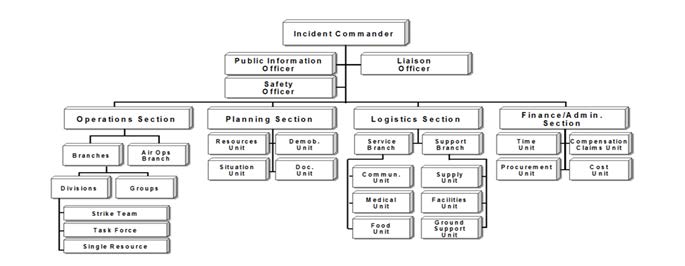
The ICS model has a reporting structure led by an Incident Commander. The Incident Commander has seven direct reports, that include four section heads plus a public information officer, a safety officer, and a liaison officer. Under the Operations Section, there are two branches: one general branches section and one air ops branch. Under the general branches section, there are divisions and groups. Under the divisions, there is a strike team, a task force, and a single resource.
Under the planning section, there are four areas: the resource unit, the demobilization unit, the situation unit, and the documents unit.
Under the Logistics Section, there are two branches: the service branch and the support branch. Under the service branch, there is the communications unit, the medical unit and the food unit. Under the support branch, there is the supply unit, the facilities unit and the ground support unit.
Finally, under the Finance/Administration Section, there is a time unit, a compensation claims unit, a cost unit and a procurement unit.
The ICS model also provides a supervisory and reporting structure. When assigned to an ICS structure, personnel will report to their ICS supervisor for the period of their assignment. Upon completion of their assignment, they will revert to their normal supervisor and reporting structure.
ICS Principles
Standardization: ICS establishes common terminology and standard processes for planning and managing resources, allowing diverse incident management and support organizations to easily work together within an ICS organization.
Command: The IC has overall responsibility for managing the incident and should have the necessary training, experience and expertise to serve in this capacity. It is possible that the IC may not be the highest ranking officer on-scene. Depending on the size and complexity of the incident, the IC may assign staff to specific functions on his/her behalf (e.g. Public Information Officer, Safety Officer, Planning Section Chief, Logistics Section Chief, etc).
An ICS organization may be expanded into a Unified Command (UC) that brings together ICs from key organizations involved in an incident in order to coordinate an effective response, while continuing to carry out their own jurisdictional responsibilities. The UC links the organizations responding to the incident and provides a forum for making consensus decisions. Should consensus not be achieved, the organization with primary jurisdictional authority has the final say.
Planning: Incident management using ICS is normally accomplished by managing objectives through the development of an Incident Action Plan (IAP). An IAP is a verbal or written plan that outlines general objectives, describes the overall strategy for managing an incident, and identifies operational resources and assignments. IAPs provide supervisory personnel with direction and actions to be implemented during a specified operational period.
Resource Management: Comprehensive resource management within an ICS organization requires processes for categorizing, ordering, dispatching, tracking and recovering resources. This provides an up-to-date picture of Tactical Resources (i.e. personnel and major equipment available to the operational function), and Support Resources (e.g. food, communications equipment, tents, etc.)
Tactical / On-Scene Communications: A common Communications Plan is needed to ensure that responders can communicate with one another during an incident. Communications equipment, procedures and systems must be interoperable across jurisdictions. Multiple communications networks may be established, depending on the size and complexity of the incident.
ICS in Canada
ICS is currently being used by many different agencies within the broader safety and security community, across a wide range of incident response categories, at the federal, provincial and territorial level.
At the provincial level, various emergency response management systems based on the ICS methodology have been adopted, including within Emergency Management British Columbia, and British Columbia Ministry of the Environment.
The adoption of ICS is also gaining momentum across a number of federal departments, including within Public Safety Canada, Department of Foreign Affairs Trade Development Canada, the Public Health Agency of Canada, Canadian Food Inspection Agency, and Transport Canada.
ICS Implementation within the Canadian Coast Guard (CCG)
The CCG is in the process of adopting ICS as its methodology for incident management and is currently in year three of its five-year implementation plan. All five main components of ICS implementation are expected to be completed by the end of fiscal year 2017/18:
- Development of foundational ICS Documentation - (Expected completion by November 2015);
- ICS Training for CCG personnel across Canada - (Appropriate training of 2,800 Department of Fisheries and Oceans/CCG personnel expected by the end of 2017/18);
- Design and construction of a National Situation Centre to support incident management – (Expected completion by end of 2015/16);
- Acquisition of an ICS Information Management System to track and manage response actions – (Expected to be operational by the end of March 2016); and
- An Exercise Program to ensure interoperability with partners, and validate documentation and training – (ICS exercises are expected to occur as planned, in August 2016, fall 2016 and fall 2017).
Area Response Planning
In 2013, the Government of Canada announced the creation of a Tanker Safety Expert Panel which was created to review Canada’s current regime and propose further measures to strengthen it. The Panel’s report was released in December 2013 and contained 45 recommendations. It noted that Canada requires a regime that takes into account variations across regions and adapts to vessel traffic, oil movements, as well as environmental and socio-economic sensitivities.
In response to the Panel’s report, the Government of Canada began a process to pilot Area Response Planning (ARP) in four pilot areas, of which includes Southern British Columbia. Area response plans will be developed in collaboration with all relevant partners, including Response Organizations, First Nations, stakeholders and other government departments. This initiative will consider geography, local risks, environmental sensitivities, and traffic volumes, and will ensure that the appropriate spill clean-up equipment is in place and readily available. The area response plans will have a tailored set of standards and requirements for Response Organizations.
Lessons learned from these four areas will be used to refine the ARP model, and in the future, will allow the Government of Canada to consider options for implementing this spill response planning approach in other locations across Canada.
Currently, Area Response Planning (ARP) is at the communications stage and the next phase, engagement with partners, will follow. The pilot area response plans are anticipated to be completed by 2017.
ANNEX D - Lexicon
- AC
- Assistant Commissioner
- ARP
- Area Response Planning
- BC
- British Columbia
- BDZ
- Brigadier General Zalinski
- CCG
- Canadian Coast Guard
- DFO
- Department of Fisheries and Oceans
- DGIR
- Dangerous Goods Incident Report
- DO
- Duty Officer
- EC
- Environment Canada
- ECC
- Emergency Coordination Centre
- EERO
- Environmental Emergencies Response Officer
- EMBC
- Emergency Management British Columbia
- EOC
- Emergency Operations Centre
- ER
- Environmental Response
- EU
- Environmental Unit
- FMO
- Federal Monitoring Officer
- GIS
- Geographic Information System
- ICP
- Incident Command Post
- ICS
- Incident Command System
- IFO
- Intermediate Fuel Oil
- IT
- Information Technology
- ITOPF
- International Tanker Owners Pollution Federation
- JRCC
- Joint Rescue Coordination Centre
- LOU
- Letter of Understanding
- MCTS
- Marine Communications and Traffic Services
- MOE
- Ministry of Environment
- MOU
- Memorandum of Understanding
- NASP
- National Arial Surveillance Program
- NCC
- National Coordination Centre
- NEEC
- National Environmental Emergencies Centre
- NHQ
- National Headquarters
- NINP
- National Incident Notification Procedure
- NOTSHIP
- Notices to Shipping
- OSC
- On Scene Commander
- PIO
- Public Information Officer
- PMO
- Project Management Office
- PMV
- Port Metro Vancouver
- RO
- Response Organization
- RMIC
- Regional Marine Information Centre
- RP
- Responsible Party
- SAR
- Search and Rescue
- SCAT
- Shoreline Cleanup and Assessment Technique
- SOPF
- Ship-Sourced Oil Pollution Fund
- SRO
- Senior Response Officer
- TSEP
- Tanker Safety Expert Panel
- TC
- Transport Canada
- UAV
- Unmanned Aerial Vehicle
- VFPA
- Vancouver Fraser Port Authority
- VTS
- Vessel Traffic Services
- VTZ
- Vessel Traffic Zone
- WCMRC
- Western Canada Marine Response Corporation
ANNEX E - M/V Marathassa's Material Safety Data sheet
ANNEX F - Port Metro Vancouver and the Canadian Coast Guard's Letter of Understanding
- Date modified:
